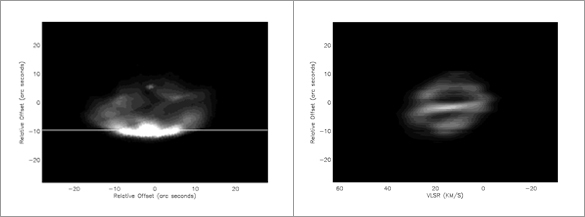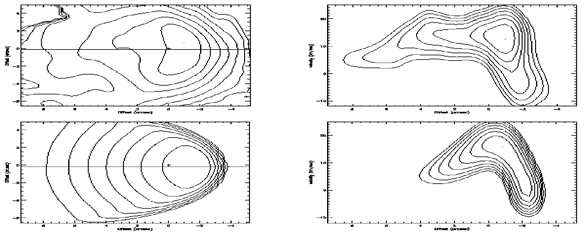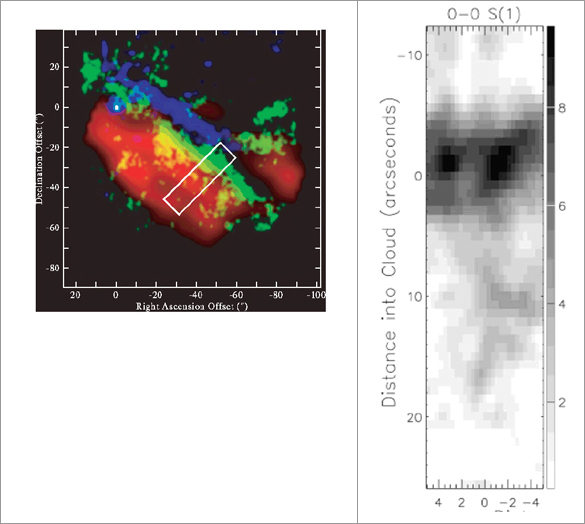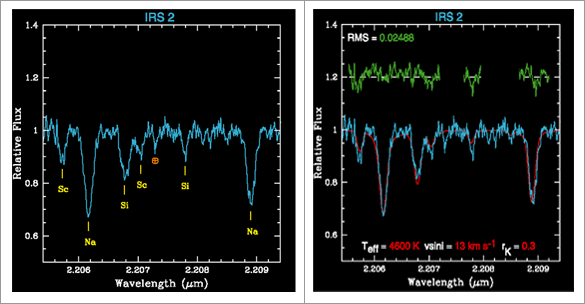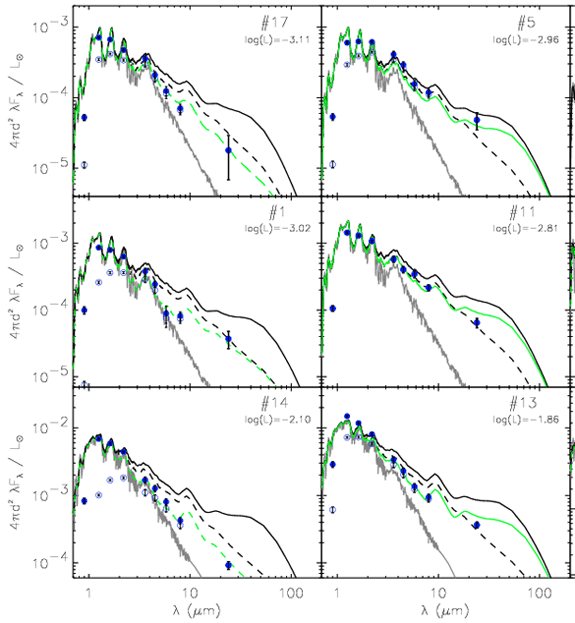Star Formation: From the Massive to the Minute
I study star formation and the earliest phases of stellar evolution. Because much of this takes place when the stars are still heavily embedded in their natal clouds, we do most of the observational work at infrared wavelengths, principally using spectroscopic techniques. Infrared spectroscopy is a fairly new field. A good deal of our effort goes into learning how to retrieve astrophysically important information from the spectra. For both technical and astronomical regions, it makes sense to divide work on young stellar objects into three categories: Massive protostars will eventually become O and B type stars. These objects largely form in clusters and have a profound influence on the interstellar material in the cores out of which they have formed. Young objects with masses comparable to the sun can form in clusters with the OB stars or in isolation. It is as yet unclear what the lower mass limit is for objects that form like stars. The lowest mass young objects are only now becoming accessible to spectroscopic investigation.
Ultracompact HII Regions
|
|
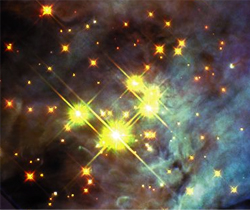
NASA |
Massive stars form quickly and finish most of their pre-main sequence evolution while still enshrouded in massive and opaque circumstellar envelopes. One of the earliest manifestations of O-type stars are the dense ionized regions known as ultracompact HII regions that develop as the stellar surface temperatures become hot enough to ionize hydrogen. Most studies of UCHII regions have been carried out in the radio using the VLA. We have been making use of Texes, a mid-IR spectrograph developed at UT, to map emission in the 12.8 µm fine-structure line of ionized neon. Because neon ions have a large atomic weight, the NeII line is not as strongly broadened by thermal motions as the hydrogen lines observed in the radio. As a result, the 12.8 µm line is a perfect probe of the mass motions in UCHII regions. We have been using measurements of the neon line to try to understand the dynamical evolution of the regions.
(click to enlarge)
Map of the UCHII region MonR2 in the 12.8 µm line of NeII (Jaffe et al. 2003). The left panel shows a map of the UCHII region. The line designates the position of the cut shown at the right. The right panel shows the velocity of the line emission versus position along the cut. There is a broad line at position 0, a double peaked line on either side, becoming a single velocity component at the extreme ends of the emission.
(click to enlarge)
The left panels show the observed (top) and model (bottom) distributions of NeII emission toward the UCHII region G29.96-0.02 (Zhu et al. 2005). The model is for an HII region confined by a stellar bow shock. There is remarkably good agreement in the morphology of the position-velocity diagrams (right) along the cuts indicated in the right-hand panels.
Photodissociation Regions
Ultraviolet light emitted by the young massive stars at wavelengths too long to ionize hydrogen escapes from ultracompact and later compact HII regions and is able to have a profound influence on the chemistry and energetics of the remaining molecular gas in the core out of which the stars have formed. We have been using Texes to study the rotational lines of H2 in the mid-IR. These lines allow us to probe the temperature structure of the hot molecular boundary at very fine spatial scales.
(click to enlarge)
(left) Chemical structure of the molecular bar at the edge of the Orion nebula. The blue shows emission by polycyclic aromatic hydrocarbons, the green shows emission by molecular hydrogen and the red by carbon monoxide. (right) Distribution of emission in the 17 µm line of H2 within the white box in the left-hand panel (Allers et al. 2005). The H2 emission comes from a region at the edge of the molecular cloud where the temperatures reach several hundred degrees.
Recent papers about high-mass star formation
Mass Flows in Cometary Ultracompact H II Regions, Zhu, Qing-Feng, Lacy, John H., Jaffe, Daniel T., Richter, Matthew J., and Greathouse, Thomas K. 2005, ApJ, 631, 831
H2 Pure Rotational Lines in the Orion Bar, Allers, K.N., Jaffe, D.T., Lacy, J.H., Draine, B.T., and Richter, M.J. 2005, ApJ, 630, 368
High-resolution observations of the near-infrared emission from NGC 6822 Hubble V, Lee, Sungho, Pak, Soojong, Lee, Sang-Gak, Davis, Christopher J., Kaufman, Michael J., Mochizuki, Kenji, and Jaffe, Daniel T. 2005, MNRAS, 361, 1273
A CS J=5-->4 Mapping Survey Toward High-Mass Star-forming Cores Associated with Water Masers, Shirley, Yancy L., Evans, Neal J., II, Young, Kaisa E., Knez, Claudia, and Jaffe, Daniel T. 2003, ApJS, 149, 375
Kinematics of Ultracompact H II Regions Revealed: High Spatial and Spectral Resolution Mapping of the 12.8 Micron [Ne II] Line in Monoceros R2, Jaffe, D.T., Zhu, Q., Lacy, J.H., and Richter, M.J. 2003, ApJ, 596, 1053
Early Evolution of Solar Type Stars
|
|
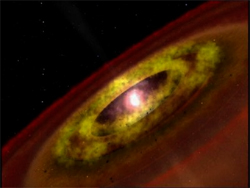
Astronomy |
Quantitative Infrared Spectroscopy of T Tauri Stars
While our understanding of main-sequence and post main-sequence evolution is mature, the picture of the formation and pre main-sequence evolution of stars like the sun is much less firmly established. Extinction by circumstellar dust make the usual techniques of optical astronomy problematic. In addition, emission due to accretion or to a protoplanetary disk mask the line and continuum emission from the stellar photosphere. By using high resolution infrared spectroscopy, we can avoid both of these problems and measure temperatures, surface gravities, and rotation rates for young stars, as well as determining the contribution of hot dust in the disk to the near-IR continuum.
(click to enlarge)
High resolution near-IR spectrum of a young stellar object in the Ophiuchus molecular cloud. The left panel identifies the lines in a small spectral interval in the K band. The right panel shows the best fit for temperature, rotation rate, and non-stellar emission (Doppmann, Jaffe, and White 2003).
Recent papers about solar-mass young stellar objects
Evidence for J- and H-Band Excess in Classical T Tauri Stars and the Implications for Disk Structure and Estimated Ages, Cieza, Lucas A., Kessler-Silacci, Jacqueline E., Jaffe, Daniel T., Harvey, Paul M., and Evans, Neal J., II 2005, ApJ, 635, 422
Results from the TEXES/IRTF H2 Survey of Disk Sources, Richter, Matthew J., Lacy, John H., Jaffe, Daniel T., Bitner, Martin A., Greathouse, Thomas K., and Blake, Geoffrey A. 2005, IAU Symposium 231, 99
Looking for Pure-Rotational H2 Emission from Circumstellar Disks, Richter, M.J., Jaffe, D.T., Lacy, J.H., and Blake, G.A. 2004, ASP Conf. Ser. 324, 232
Stellar Properties of Pre-Main-Sequence Stars from High-Resolution Near-Infrared Spectra, Doppmann, G.W., Jaffe, D.T., and White, R.J. 2003, AJ, 126, 3043
A Spectroscopic Technique for Measuring Stellar Properties of Pre-Main-Sequence Stars, Doppmann, G.W., and Jaffe, D.T. 2003, AJ, 126, 3030
The Least Massive Young Brown Dwarfs
|
|

CfA |
In order to understand the process of star formation and the physics and evolution of protoplanetary disks, it is useful to have a sample of objects spanning the broadest possible range of masses. Over the past few years, a number of young objects have been found with nominal masses down to around the deuterium burning limit (~12 MJupiter). We have used results from the Spitzer Legacy Program "From Cores to Disks" and our own sensitive near-IR imaging to develop a sample of 1-3 million year old brown dwarfs with accompanying disks. Some of these objects have luminosities as low as 1/1000 that of the sun and have nominal masses as low as 6 MJupiter (Allers et al. 2006). We can use the broad-band near-IR and mid-IR colors to begin to characterize the objects and their disks. Near-IR spectroscopy (now under way) will reveal more about the nature of the sources.
(click to enlarge)
Spectral energy distributions for young brown dwarfs with disks (Allers et al. 2006). The grey lines show models for brown dwarf photospheres while the dashed and black lines show various models for reradiation by a protoplanetary disk. Each panel lists the luminosity of the central object.
Recent papers about young brown dwarfs with very low masses
Young, Low-Mass Brown Dwarfs with Mid-Infrared Excesses, Allers, K.N., Kessler-Silacci, J.E., Cieza, L.A., and Jaffe, D.T. 2006, ApJ, in press (astro-ph/0602249)
Young, Jupiter-Mass Objects in Ophiuchus, Allers, K. N., Jaffe, D. T., van der Bliek, N. S., Allard, F., Baraffe, I., to appear in the proceedings of "The Spitzer Space Telescope: New Views of the Cosmos" a meeting held 9-12 November 2004 (astro-ph/0506079)
